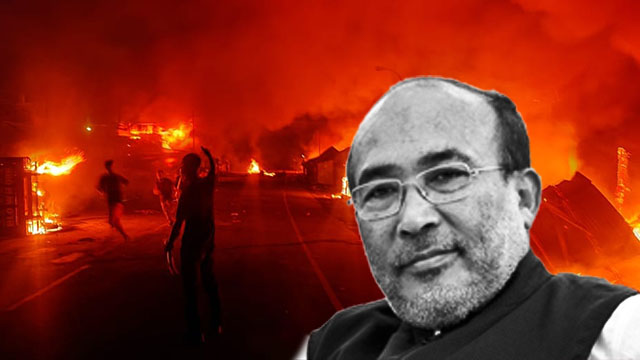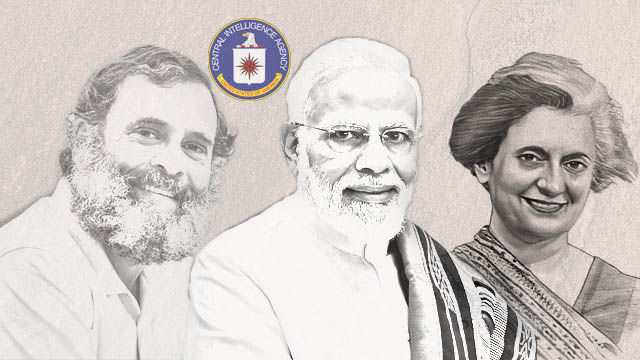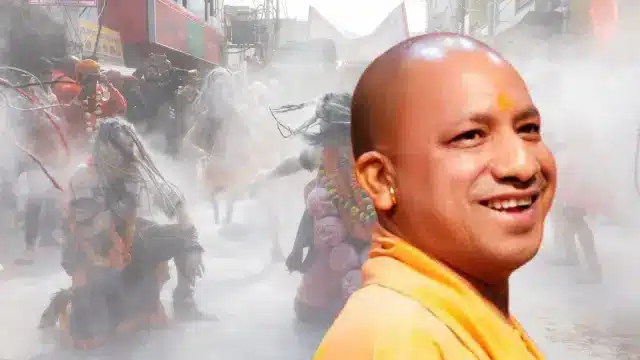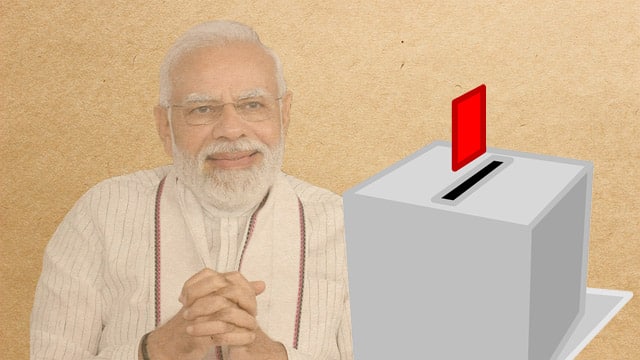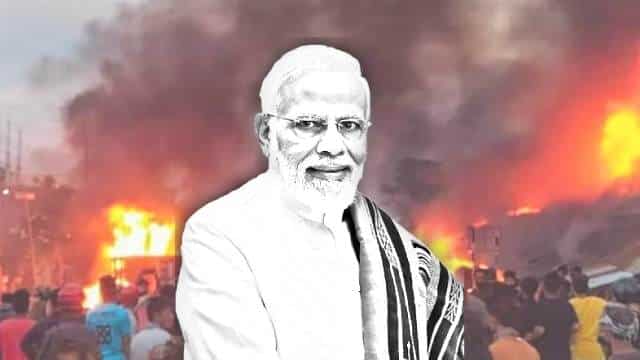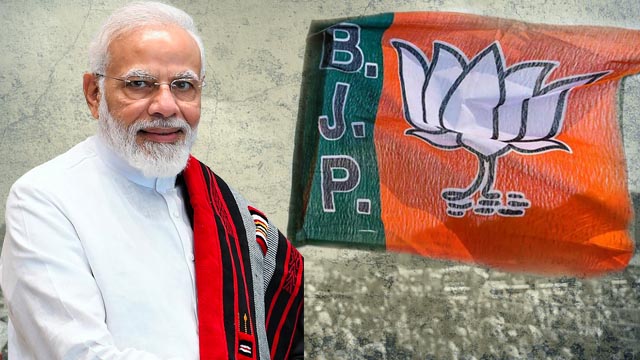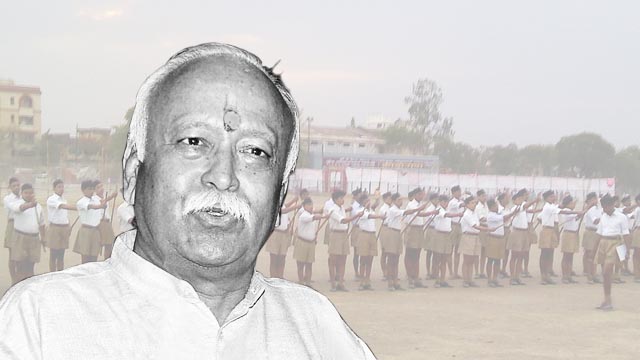A week ago, Manipur was engulfed in flames after a rally organised by the All-Tribal Students’ Union of Manipur (ATSUM) to protest the Manipur High Court’s April 2023 directive to the state government to share its recommendation regarding the inclusion of the state’s dominant, valley-based Meitei community in the scheduled tribe (ST) category turned ugly in the Churachandpur district. The Manipur violence has so far claimed around 54 lives, wounded many and displaced over 25,000 people who have been evacuated by the Indian Army.
Following the skirmish in the Churachandpur district on Wednesday, May 3rd, ethnic violence between the dominant Meitei community and the hill-based Kuki and other tribal communities intensified. Hundreds of houses have been torched, loot and arson took place in galore, and places of worship were attacked and set ablaze. All these took place while the ruling Bharatiya Janata Party’s (BJP) government and Chief Minister N Biren Singh remained mute spectators. No concrete steps were taken to douse the fire at the very onset.
But why did Manipur burn? What has caused this recent tranche of Manipur violence? Is this a communal clash between predominantly ‘Hindu’ Meiteis and ‘Christian’ Kukis, who are accused of being ‘illegal settlers’ in Manipur? Or is this an outburst of pent-up anger, which had been simmering for a long time beneath the surface? Different perspectives point to different reasons behind the Manipur violence; however, it’s generally agreed that the government’s inactions played a major role. Moreover, the violence also exposed the widening social fissures in the state.
Inside Manipur violence: Pent-up anger of the tribals
Contrary to the popular north Indian perception about Manipur, or for that matter the entire northeast, there are no homogeneous people in the state, but a multitude of them whose diverse languages, cultures and traditions have amalgamated over centuries. Yet, there remain severe socio-economic contradictions in Manipur, which are intensifying due to fast-changing economic realities and reducing scopes for livelihood in the state.
The tribal, hill-based Kuki community has been at loggerheads with the BJP-led state government since the latter started a clampdown on tribal settlements in the reserved and protected forest areas. The Kukis have alleged that the BJP government has been persecuting them, evicting them from their villages and destroying their farmlands under the garb of protecting forest areas.
According to the BJP-led state government, it has been clamping down on illegal encroachments built on protected and reserved forest areas. Singh’s government has identified its drive against ‘illegal poppy cultivation’ in alleged ‘encroached’ forest land as a ‘war against drugs’. It has also accused the Kukis of indulging in cross-border drug smuggling, which has enraged the tribal community.
Apart from these, the BJP government has been labelling the Chin tribals who fled neighbouring Myanmar due to ethnic persecution by its junta government, as ‘illegal migrants’ following the legal norms set by the Citizenship (Amendment) Act 2003 (CAA 2003), which calls for a National Register of Indian Citizens (NRC) and disenfranchisement of those who don’t fulfil stringent citizenship criteria. The government’s tirade against the Chin community has also irked the Kukis, who consider the latter as their kin.
In the meantime, the BJP-led state government has reportedly evicted thousands of tribal villagers, especially in the Churachandpur district, accusing them of encroaching on protected and reserved forest land. While the tribal people have considered the forests their ancestral property and considered moving to forest land due to the increase in population in the villages as a birthright, the government’s criminalisation of their centuries-old practice has triggered massive discontent.
In November 2022, the state government issued a notice and de-recognised 38 villages in Churachandpur and Noney districts. The government demolished the houses in K Songjang village in the Churachandpur district and the villagers were evicted. The government claimed that the villages were not present in 2020 per satellite imagery on Google Maps. The tribals claimed that the villages had been there for over five to six decades.
The BJP government has even nullified the surveys done by assistant survey officers (ASO) who excluded villages in the Churachandpur-Khoupom Protected Forest area in the Churachandpur district. Although the government can nullify an ASO’s order only after a survey of the area, Singh didn’t take that route and unilaterally publicised the decision through a gazette notification. This has even irked the Kukis in the BJP’s fold.
Paolienlal Haokip, the BJP’s member of the legislative assembly (MLA) from 59 Saikot Assembly constituency, protested the government’s decision to suddenly survey the Churachandpur-Khoupum Protected Forest. MLA Haokip demanded that the selective surveys be immediately stopped until similar survey programmes are undertaken for all reserved and protected forest areas in Manipur. He had warned the government in April that such surveys will be perceived as threats by the tribals as they appear quite selective.
However, the BJP government chose to ignore the MLA’s demands and pursued its single-track agenda, which again angered the Kukis. The BJP government even discussed plans to implement the inner-line permit (ILP) system in Manipur for a few tribal communities, whom it categorised as ‘outsiders’. This has irked not only the tribal communities of Manipur but the entire neighbourhood.
Even in neighbouring Mizoram, the tribal organisations became furious over the forceful eviction of the Zo tribals from the hilly tracts of Manipur. A Mizo tribal organisation demanded that the BJP-led Manipur government discard its ILP proposal for the Zo and other tribes, who are ethnic communities with roots in the region, a few days before the Manipur violence started. Singh’s government chose to ignore the demands.
The root cause of the Manipur violence
The hostility exhibited by the Meiteis and Kukis against each other in different parts of Manipur is rooted in the antagonistic relationship between these ethnic groups over the share of power and resources. The valley-based Meiteis, who account for 53% of Manipur’s population, are socio-economically advanced vis-à-vis the Kukis and have more access to resources. Still, the Meiteis consider themselves a tribe and many of them seek the ST status. This is opposed by the Kukis and other tribes for different reasons.
Firstly, the Kukis and other tribes allege that the socio-economically advanced Meiteis had been an agrarian community in the valley and not tribals.
Secondly, the tribals fear that once the Meiteis get the ST status they will start moving towards the hills and buy land there, which they can’t do now due to the prevalent laws that prevent non-tribals from doing so.
Finally, the Kukis and other tribes fear losing the minimal access they have to public education and government jobs as STs in the state. They fear their share in these sectors will be eaten up by the Meiteis.
Out of these, the fear of getting displaced has overwhelmed the Kukis and other tribal communities in Manipur. They stand opposed to the Meiteis gaining an opening to the ST status, which they see as a threat to their existence and livelihood. Hence, they have been organising protest rallies and stirring mass movements against the planned move by the dominant community backed by the BJP-led state government.
While this antagonism between the Meiteis and the Kukis prevailed for years, the fissures were buried for some time, especially after most Manipuri militant organisations entered a ceasefire arrangement with the government. However, the BJP government’s alleged persecution of the Kukis, the eviction of the tribals from their villages and Prime Minister Narendra Modi-led Union government’s plan to start large-scale palm oil cultivation in the northeast, including Manipur, have played some role in deteriorating the situation.
In the meantime, the pursuit of the ST status by a group of Meiteis and the Manipur High Court’s directive to the state government to share the recommendations regarding the inclusion of the Meitei tribe in the ST list, etc, have sparked the flame that transformed into a mammoth prairie fire in the hills and the valley of Manipur, killing dozens and displacing thousands.
The BJP’s ‘divide and rule’ policy
The BJP government has not only allegedly persecuted the tribal communities, amid the Manipur violence, but the saffron camp’s apparatchiks had also portrayed the conflict as a communal one on social media to polarise the Hindus in northern India. They alleged that the Manipur violence was sparked by the ‘outsider’ Kukis, who are Christians. They alleged that the Christian Kukis attacked ‘Hindu Meiteis’ and forced the latter into an exodus from their homeland. This narrative gained traction on social media.
However, the fact is that there is no homogenous religious identity of the Meiteis or the Kukis or other tribes. Manipur has over 33 tribes, belonging to the Naga or Kuki conglomerates. While the Nagas share ethnicity with those living in Nagaland, the Kuki tribes’ members are a sub-family of the Tibeto-Burman language group and are related to Mizo tribes in neighbouring Mizoram and the Chin tribe of Myanmar. Among these communities, there are followers of different religions, sects and denominations.
According to the 2011 Census, Manipur has 41.39% Hindus and 41.29% Christians, while 8.19% of its people belong to unclassified religions and sects, especially in the hilly regions. Although most Meiteis are Hindus, many of them are also Christians. Several Meiteis also follow Sanamahism, a polytheistic indigenous animistic ethnic religion of Manipur. Similarly, though most Kukis are Protestant Christians by religion, there are many followers of other sects among them.
During the Manipur violence, several churches of the Meiteis were burned down. The attack didn’t come from Hindu Meiteis, but those who have been villianised by the Hindutva camp on social media as ‘outsider’ Christians. Similarly, the places of worship of the Kukis came under attack from Meiteis of different religions. Both were not blinded by religious bigotry but ethnic hatred, which fuelled the violence and, here, unlike in other BJP-ruled states of northern and western India, religion had very little role to play.
What’s left?
The recent Manipur violence was a fratricide. The wounds caused by this violence, the bloodshed, the losses and the displacement shall not heal soon. As several militant organisations have engaged in an armed confrontation with the Indian Army and paramilitary troops in Manipur, it’s estimated that this new lease of violence may pave the way to another sequence of ethnic tension and militancy in the state.
The ruling BJP can’t escape its responsibility. It failed in maintaining law and order, and Article 355 was reportedly invoked by the Union government. When the state government called for an all-party meeting, it was too late. It seems that by the time the political parties, which are mostly Meitei organisations with little or no presence among the Kukis, will implement the decisions of the all-party meeting, especially regarding the establishment of ‘peace committees’ in each assembly constituency, the conflict in the state may reach a new stage.
What Manipur requires now is a peaceful environment, which can be created only by the state government by retreating from its alleged anti-tribal eviction drives and by engaging the marginalised communities and militant groups in dialogues. Manipur’s inclusive economic development, creation of more secure employment opportunities for the people and improving the living standards of the tribals are steps that the government must take to quell any scope of violence.
It’s highly unlikely that the BJP government will suddenly change its modus operandi. That will collide with its political objectives in Manipur and the northeast. In this case, the menace of Manipur violence will hover over the people of all communities and tribes. And violence will not just cause social and personal trauma for people but also block the possibilities of growth and development for the Manipuri people. Whether and how the government overcomes this roadblock is what Manipuris and others from the east and northeast should look forward to.
Tanmoy Ibrahim is a journalist who writes extensively on geopolitics and political economy. During his two-decade-long career, he has written extensively on the economic aspects behind the rise of the ultra-right forces and communalism in India. A life-long student of the dynamic praxis of geopolitics, he emphasises the need for a multipolar world with multilateral ties for a peaceful future for all.

